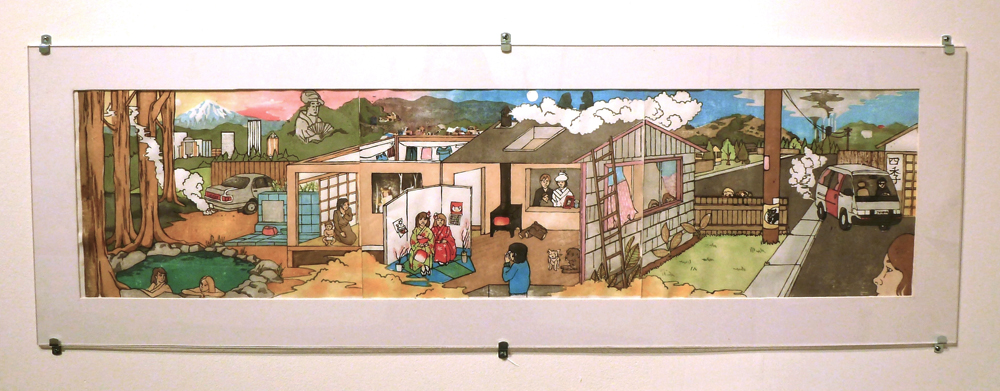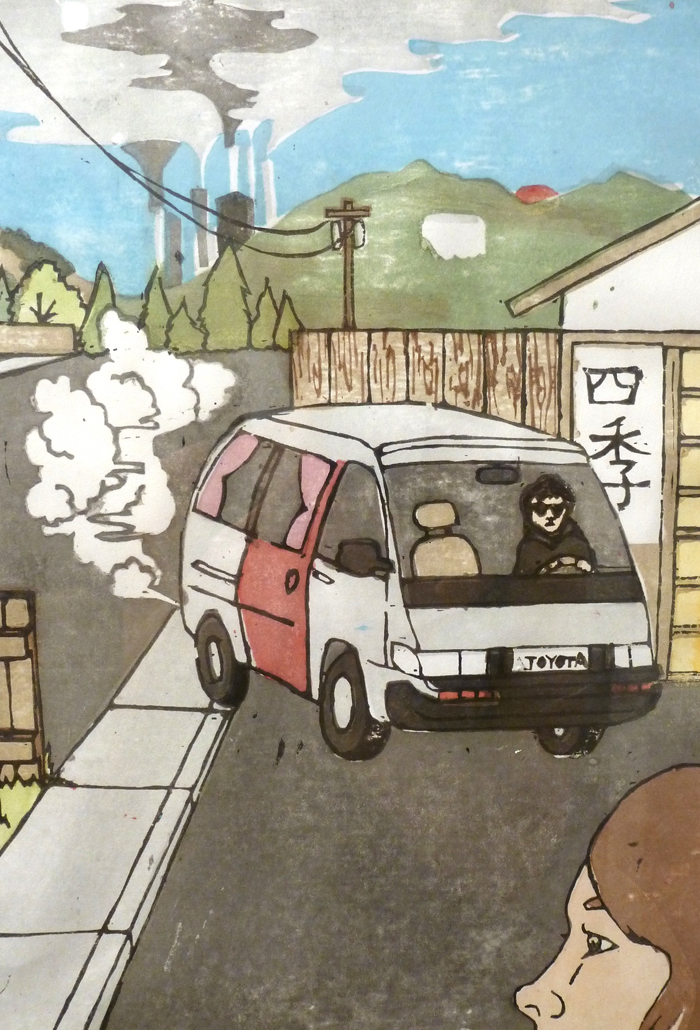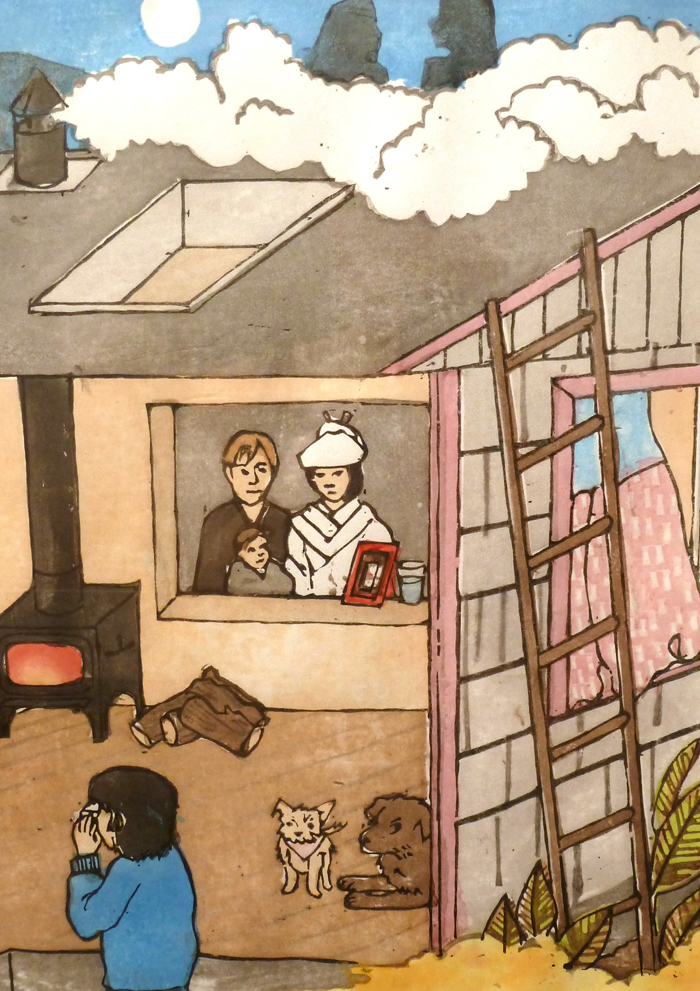‘Look Again’ by Maria Maita-Keppeler | Portland, Oregon, USA
TOPIC: TRANSLATIONS
Look Again: Formation of Mixed Race Identity through Revisitations of Ukiyo-e

The current era of globalization and immigration has brought about an America in which nine million individuals, or 2.9% of the population identify as mixed race. The search for the understanding of this identity becomes increasingly important as society begins to identify “mixed race” as a racial category and subject it to the same prejudices and discrimination as other minority races. Today the mixed race individual is often projected through a lens of celebration, exoticism, or otherness that simplifies the individual. Thus, it is increasingly important for the personal accounts and experiences of mixed race individuals be represented. Processes of self-exploration are vital starting points for generating counter-narratives that expand the meaning of mixed race identity in today’s context.
I am a half Japanese, half American individual and through the practice of traditional Japanese woodblock printmaking, influenced by the Ukiyo-e prints of 18th Century Japan, I examined my personal narrative. The phrase “Look Again” is loosely translated from the Japanese phrase “mitate”, a genre of Ukiyo-e in which prints reenact or parody classical literary or historical scenes within a contemporary setting. In my work I reset the stage for mitate-e so that my self and my world represented the contemporary, and the mitate-e of Edo Japan became the classical.

I carved high quality Japanese shina and cherry wood with Japanese knives and used rice paste to adhere Japanese sumi ink and watercolors to handmade washi paper. The challenge of recreating Japanese printmaking in Portland, Oregon illuminated the difficulty of transmitting history into a new time and place. The preservation of a traditional Japanese craft required a delicate and hands-on process that became as vital as the product. My actions of hand carving and hand printing became an act of identity-forming, as I became both mentally and physically closer to the unique art of Japanese printmaking.
M and T (Figure 1 and 2), show female bust-length figures modeled after the Edo period okubi-e format. Both figures are based on Kitagawa Utamaro’s close up beauty portraits which use physical characteristics to categorize women. By portraying the multiracial bodies of my sister and me, the difficulties of categorization based on physical terms are brought to light. M and T, reveal the inadequacy of such a system by representing physical features for which there are no real categories, the gestures—picking at eyelashes, pulling out hair— physically embody the anxieties that accompany societal tendencies towards categorization. Unlike Utamaro’s portraits of women caught unaware in their “natural state”, the prints capture self-conscious moments where the subject is aware that their features are displayed and examined. This reflects a common experience for mixed race individuals: Just as an art history scholar might look at an Utamaro work and attempt to decipher the rank or category of the woman depicted, so too do people examine mixed race individuals based on their physical characteristics and attempt to identify their race.

A Childhood Story (Figure 3), retells a non-traditional personal narrative through traditional Japanese storytelling devices. Read from right to left, the story itself loosely follows the characters of my sister and me.

The story depicted is a piecemeal of personal memories, aural storytelling, old photographs, and even Google Maps. It highlights the fragmentary nature of exploring personal narratives, which plays a vital role in the formation of an identity. I show this fragmentation through a non-linear timeline: in the center a recent painting of my sister hangs in the hallway of the house where she is still a child, silhouettes of my sister and me all grown up are perched upon a roof while our younger selves sit for photos in the room below, to the left my grandmother plays with me as a baby while my adolescent self bathes in a natural hot springs a short distance away.
The narrative begins on the right with the Western-inspired, one-point perspective used by many ukiyo-e artists. This breaks down in the second panel where three dimensional space is represented with simple diagonals rather than a vanishing point, as was done in very early Asian paintings.
Through these varied perspectives I explore multiple facets of my world, from my childhood home in Oregon to my mother’s Japanese hometown, from my infant-hood to my adult-hood. As a single “big picture” they represent the unique complexities of my history and my identity. This reflects a freedom from categorization, from being forced to choose between my American identity and my Japanese identity. Those identities, like the visual elements within this triptych, are intertwined and inseparable.

The universal mixed race experience is near impossible to convey, as a similarity in racial heritage is by no means a significant commonality between individuals. Yes, students now have the option to self-identify as “mixed race” on standardized tests, but what does “mixed race” really mean? For both Two Portraits and Childhood Triptych, the personal experience takes center stage as I shuffle through family photographs and hunt through memories in order to convey an experience that is honest and untold.
I combine the “western” views I learned growing up in the United States with my new knowledge of traditional Japanese printmaking in order to create an image that is rooted deeply in both Japanese and American cultures. Through learning and performing methods of Japanese printmaking I created a tactile and intimate connection with an exquisite tradition, and participated in the transmission of knowledge and history that is vital to my identity.
By resisting the urge to attempt to come to a universal conclusion about mixed race identity and by denying that my experience fits into some kind of category for what it means to be mixed race, I assert perhaps the few truths on the matter: that each experience is unique, that each identity is formed differently, and that each story that is told has the potential to open up a dialogue for further illumination of what the mixed race identity is.